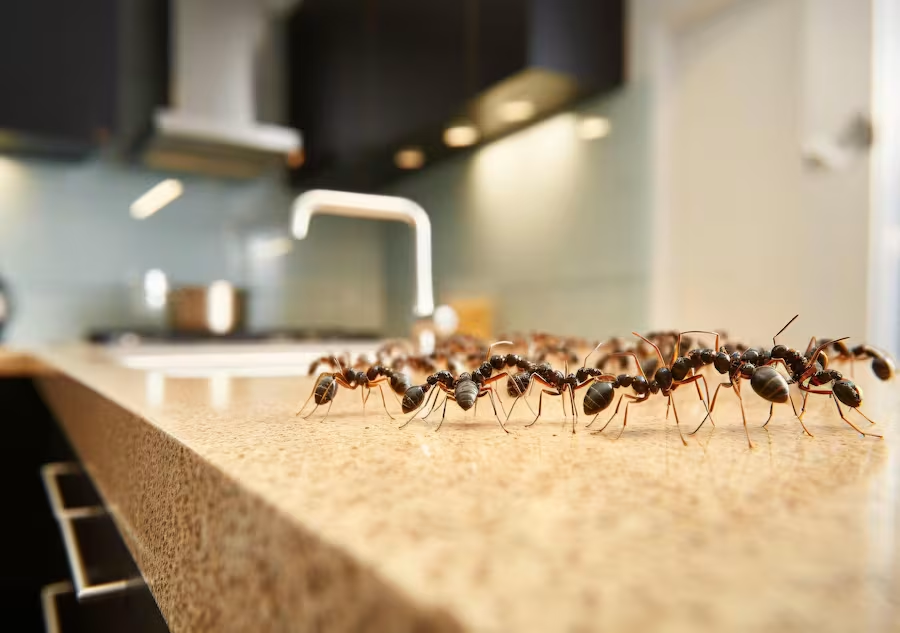Discovering an ant invasion in your kitchen can quickly turn a peaceful morning into a frustrating battle. These tiny creatures march in search of food, creating scent trails that lead entire colonies straight to your kitchen counters and food containers. Understanding how to eliminate kitchen ants effectively can save you from this all-too-common nuisance for homeowners.
Whether you’re dealing with a few scout ants or facing persistent infestations, this guide covers various methods—from natural remedies to chemical solutions—that will help you reclaim your space. We’ll explore how to identify the type of ant causing trouble, locate their hidden nests, and implement preventative measures to ensure these unwanted guests don’t return.
Understanding Why Ants Invade Your Kitchen
Ants enter homes in search of food and water, with the kitchen being particularly attractive due to the abundance of resources. These industrious insects communicate through pheromone trails, effectively guiding other members of their ant colony directly to sources of food they’ve discovered. Once they find sweet foods, sugary substances, or even pet food bowls, they’ll continue returning until the original food source is eliminated.
Most kitchen ants are simply following their natural instincts, seeking sustenance to support their massive colonies. They have an impressive sense of smell that helps them detect even the slightest food residue or greasy residues left on surfaces. Understanding this behavior is the first step in creating an effective ant control treatment plan.
Common Reasons Ants Enter Homes
- Food accessibility – Crumbs, spills, or uncovered food supply attract ants looking for their next meal, especially sweet scent from sugary foods or peanut butter.
- Water sources – Leaky faucets, water leaks, or even pet water bowls provide necessary hydration for ant species.
- Weather conditions – Seasonal changes may drive ants indoors as they seek shelter from extreme temperatures or precipitation.
- Existing ant trails – Pheromone trails left by scout ants can lead entire ant colonies straight to your kitchen sink or pantry.
- Accessible entry points – Cracks in foundations, gaps around windows, or spaces under doors serve as convenient ant entry points.
Types of Ants Commonly Found in Kitchens
- Odorous house ants – This common type releases a distinctive smell when crushed, often described as rotten coconut.
- Sugar ants – These small ants have a particular fondness for sweet foods and syrups.
- Ghost ants – Nearly transparent bodies make these tiny invaders difficult to spot until they form a line.
- Thief ants – Among the smallest common species, they often nest near other ant colonies.
- Black garden ant – A common species that typically nests outdoors but forages for food indoors.
Identifying the Ant Problem
Before implementing any solution, it’s crucial to identify the specific ant species invading your kitchen. Different types of ant respond differently to various treatments. Observing their behavior, size, and color can help determine the most effective approach. For instance, some aggressive species might require professional intervention, while others respond well to simple homemade solutions.
Following an ant trail can lead you to their nest entrances, which might be located in walls, under appliances, or even in garden bins outside. Understanding their movement patterns and preferred food sources will greatly improve your chances of completely eliminating the problem rather than just temporarily reducing their numbers.
Spotting the Source
- Look for ant trails along baseboards, countertops, or near the kitchen floor – these pheromone trails often lead directly to nest entrances.
- Check dark, humid areas such as under the sink, behind appliances, or in couch cushions where ants might establish hidden nests.
- Inspect the exterior of your home, particularly around windows and doors, as many ant species maintain outdoor colonies but forage indoors.
- Monitor activity at different times of day – some ant species are more active at night, while others prefer daytime foraging.
- Check the bathroom counter and even your 2nd floor bathroom, as water sources throughout the home can attract ants.
Natural Ways to Get Rid of Ants
For those preferring to avoid harsh chemicals, natural methods offer effective solutions for dealing with kitchen ants. These approaches use ingredients commonly found in most homes and pose little risk to children, pets, or food preparation areas. Natural ant deterrents can be particularly useful for minor infestations or as a preventative measure.
Vinegar and Water Spray
White vinegar serves as a powerful deterrent for ants due to its strong smell that disrupts their scent trails. Create a simple spray by combining equal parts white vinegar and warm water in a clean spray bottle. This 1-to-1 vinegar and water mixture can be applied directly to ant trails, kitchen counters, and potential entry points. The solution works by both killing ants on contact and eliminating the pheromone trails they use for navigation.
Lemon Juice
Lemon juice works similarly to vinegar, as its acidic properties help destroy scent trails while repelling ants. Squeeze fresh lemon juice or use lemon rind in areas where ants frequently appear. For a more potent solution, mix lemon juice with water in a spray bottle with water and apply it to surfaces where you’ve spotted ant activity. The citrusy scent we find pleasant acts as a natural repellent that ants actively avoid.
Baking Soda and Sugar Trap
- Mix baking soda (calcium carbonate) and sugar in equal proportions – the sugar attracts ants while the baking soda eliminates them.
- Place small amounts of this mixture near ant trails or known entry points.
- For better results, add a few drops of water to create a paste that ants can easily consume.
- Reapply as needed, especially after cleaning or when you notice renewed ant activity.
Diatomaceous Earth
Diatomaceous earth offers an effective natural method for ant control. This fine powder consists of fossilized remains that damage ants’ exoskeletons upon contact. Simply sprinkle a light residue around entry points, along ant trails, or near ant hills. While harmless to humans and pets, it’s best to use food-grade diatomaceous earth in kitchen areas. This substance works by dehydrating the ants, making it particularly effective against larger infestations when applied consistently.
Chemical Solutions for Persistent Infestations
When natural methods don’t provide adequate results, especially for severe ant infestations, chemical solutions may become necessary. These products are specifically formulated to eliminate entire colonies, not just the visible worker ants.
Ant Baits and Gels
Ant bait stations and gels work by attracting ants with appealing substances, often containing a mix of boric acid with sugar or similar attractive ingredients. The worker ants carry this poison back to their colony, eventually reaching the queen and eliminating the source of the problem. Place ant bait traps near ant trails but away from areas where children or pets might access them. For persistent problems, re-apply bait stations every few weeks until activity ceases completely.
Boric acid powder can be particularly effective, though it should be used cautiously. A mix of boric acid with sugar or peanut butter creates an irresistible lure for most common ant species. However, always keep in mind that while less toxic than many pesticides, boric acid should still be kept away from animal consumption and food preparation areas.
Ant Sprays
Contact sprays offer immediate results by killing ants on contact but typically don’t address the root cause. For more comprehensive treatment, consider using essential oil sprays containing peppermint oil, tea tree oils, or lemon eucalyptus oil. These natural acids provide a more environmentally friendly alternative to harsh chemical sprays.
For a homemade contact spray, fill a clean plastic spray bottle with water and add several drops of dish soap and a few drops of peppermint essential oil. This simple mixture disrupts the ants’ waterproof coating, effectively eliminating them when sprayed directly. Commercial glass cleaning spray products can also work in a pinch, though they may not prevent future infestations.
Preventing Future Infestations
Eliminating current ant problems is only half the battle—preventing their return requires consistent preventative measures. By creating an environment that’s less attractive and accessible to ants, you can dramatically reduce the likelihood of dealing with ant invasions in the future.
Keep Your Kitchen Clean
- Wipe down kitchen counters daily with a mild soap solution or vinegar spray to remove food residue and disrupt any existing ant trails.
- Wash dishes promptly after meals instead of leaving them in the sink overnight, as dirty dishes are a major attractant.
- Store sweet foods, pet food, and other attractants in airtight containers to eliminate the scent of food that draws ants.
- Sweep and mop floors regularly, paying special attention to areas under appliances and in corners where crumbs collect.
- Empty trash receptacles frequently, particularly if they contain food waste.
Seal Entry Points
- Inspect your home’s exterior for cracks and gaps, applying caulk to seal any potential entry points you discover.
- Check around plumbing fixtures and utility penetrations, as these often provide accessible entry for ants.
- Repair damaged screens on windows and doors to prevent ants from entering.
- Apply petroleum jelly or talcum powder around known entry points as a temporary barrier while you work on more permanent solutions.
- Use weather stripping around doors and windows to eliminate tiny gaps where ants can enter.
Maintain Dryness
- Fix any water leaks promptly, as moisture attracts many ant species.
- Avoid leaving cups of water or pet water bowls out overnight when possible.
- Use dehumidifiers in particularly damp areas of your home.
- Ensure proper drainage around your home’s foundation to prevent moisture accumulation.
- Check potted plants for overwatering, as excess moisture can attract ants seeking water.
When to Call a Professional Exterminator
While many ant infestations can be managed with DIY methods, some situations warrant professional intervention. If you’ve consistently applied various treatments without success, or if the ant problem seems to be spreading throughout your home, it may be time to consult with a pest control expert. Companies like Shield Pest Control offer specialized ant control methods that target specific species and provide longer-lasting results than most home remedies.
Professional exterminators have access to commercial-grade products and equipment that can effectively eliminate ant colonies at their source. Additionally, they can identify structural or environmental factors contributing to your ant problem and recommend appropriate preventative measures.
Signs You Need Expert Help
- You’ve tried multiple DIY solutions, but the ant invasion persists or returns quickly.
- The infestation has spread beyond the kitchen to multiple areas of your home.
- You’ve identified aggressive or potentially destructive ant species that require specialized treatment.
- Your home has structural issues that provide numerous hidden entry points for ants.
- You’re dealing with massive colonies that seem too extensive for home remedies to address effectively.
- Traditional pest control methods have failed to resolve the issue.
- You notice signs of ant colony eradication followed by quick reinfestation, suggesting nearby hidden nests.
- Your ant problem is seasonal but returns with greater intensity each year.
By understanding what attracts ants to your kitchen and implementing both reactive and preventative measures, you can effectively manage and eliminate these persistent pests. Whether you opt for natural methods like cotton balls soaked in peppermint oil or lemon eucalyptus essential oil, or choose commercial solutions for larger infestations, consistency is key to success. With proper vigilance and maintenance, you can enjoy your morning coffee without unwelcome six-legged visitors.
Prime Narratives offers expert home improvement tips, practical DIY solutions, and insightful guides to help you create a more functional, beautiful, and comfortable living space—every step of the way.



